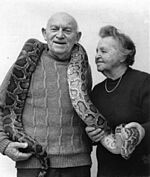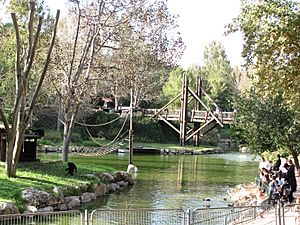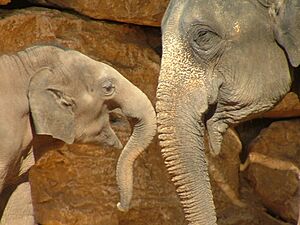Jerusalem Biblical Zoo facts for kids

The zoo's logo
|
|
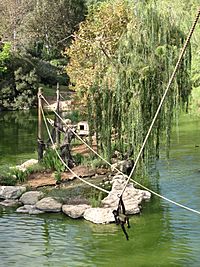
A black-handed spider monkey swings on a rope over the lake at the zoo.
|
|
| Date opened | 1940 |
|---|---|
| Location | Malha, Jerusalem, Israel |
| Land area | 62-acre (25 ha) |
| Coordinates | 31°44′58″N 35°10′37″E / 31.74944°N 35.17694°E |
| No. of animals | 2,200 (as of 2009) |
| No. of species | 271 (as of 2009) |
| Memberships | WAZA, EAZA, IZA, Species360 |
The Tisch Family Biblical Zoo in Jerusalem, often called the Jerusalem Biblical Zoo, is a famous zoo in the Malha neighborhood of Jerusalem. It is known for its large collection of animals from Africa and Asia. Many of these animals are mentioned in the Hebrew Bible.
The zoo is also very good at breeding endangered species to help save them from extinction. It was the most popular place for tourists to visit in Israel for many years. In 2009, it had a record 738,000 visitors.
Contents
History of the Zoo
The zoo was founded in 1940 by Aharon Shulov, a professor of zoology at the Hebrew University of Jerusalem. He wanted to create a place to study animals mentioned in the Bible. He also wanted to share the world of animals with everyone in Jerusalem.
Early Locations
The zoo started as a tiny "animal corner" on a street in central Jerusalem. It soon moved to a larger space on Shmuel HaNavi Street, where it stayed for six years.
In 1947, the zoo moved to Mount Scopus. This was a difficult time because of the 1948 Arab-Israeli War. It was very hard to find food for the carnivorous (meat-eating) animals, and sadly, many of them did not survive.
After the war, the zoo had to move again. It settled in the Romema neighborhood in 1950 and stayed there for over 40 years. The zoo became a much-loved place in Jerusalem, growing to over 28 acres with more than 200 types of animals.
A New Home in Malha

By the 1990s, the zoo needed more space. Teddy Kollek, the mayor of Jerusalem, helped raise money for a big move. A family from New York, the Tisch family, gave a large donation.
In 1991, the zoo closed its Romema location. It reopened in 1993 in a large, beautiful valley in the Malha neighborhood. This is where the zoo is today. In 2025, a sad event occurred when a zookeeper had a tragic accident involving a tiger.
A Tour of the Zoo Today
The zoo is now called the Tisch Family Zoological Gardens in Jerusalem, but most people still know it as the Biblical Zoo. It covers 62 acres of land and is landscaped with trees and plants native to Israel.
Park Layout and Features
The zoo is built on two levels, with a small train that takes visitors around the park. The entire park is accessible for wheelchairs.
In the center of the lower level is a large, man-made lake with islands for monkeys. Water flows into the lake from a beautiful waterfall called "Moses' Rock."
Near the entrance is a large, wooden visitor's center shaped like Noah's Ark. Inside, you can find a gift shop, a snack bar, and an art gallery. The park also has a sculpture garden with 23 amazing animal sculptures that kids can climb on.
Animal Homes

Instead of old-fashioned cages with bars, the animals live in open areas that look like their natural homes. These spaces are separated from people by safe barriers like trenches or glass windows.
The animals live in habitats that range from an African savanna to a tropical rainforest. Each animal mentioned in the Bible has a sign with a verse from the Bible in Hebrew, Arabic, and English.
The zoo also has a special children's area where kids can gently pet and feed pygmy goats, sheep, and other small animals.
Saving Animals and Nature
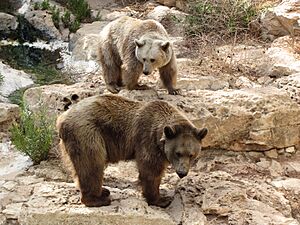
The zoo's most important job is wildlife conservation, which means protecting animals and their habitats. It focuses on saving endangered species, especially animals from the Bible that no longer live in the wild in Israel.
Breeding and Reintroduction
The zoo has special programs to breed animals in captivity. Sometimes, these animals can be reintroduced, or returned, to the wild.
Thanks to the zoo, the Persian fallow deer, once thought to be extinct, now lives again in nature reserves in Israel. The zoo also has breeding programs for the griffon vulture and the Negev tortoise.
Famous Animal Births
The zoo is a world leader in helping animals have babies. In 2005, it celebrated a huge success with the birth of Gabi, the first elephant in Israel to be born through artificial insemination. This special event was watched online by over 350,000 people around the world.
Sometimes, baby animals are rejected by their mothers. When this happens, the zoo's vets and staff take care of them, feeding them by hand until they are strong enough.
Learning at the Zoo

The zoo believes that teaching people about animals is very important. It welcomes school groups, summer camps, and families to learn about wildlife.
It is very important for visitors to be respectful and not throw food or other objects at the animals. The zoo staff works hard to teach everyone how to be a good guest in the animals' home.
The zoo also teaches about protecting the environment. It has its own water recycling system and makes compost from animal and plant waste. This compost is used to fertilize the park's gardens.
Research and Teamwork
The zoo works with scientists from around the world on research projects. These studies help us learn more about animals, how to care for them, and how to protect them in the wild.
The zoo is a member of many important groups, including the European Association of Zoos and Aquaria (EAZA) and the World Association of Zoos and Aquariums (WAZA). This teamwork helps zoos everywhere work together to save species.
See also
 In Spanish: Zoológico bíblico de Jerusalén para niños
In Spanish: Zoológico bíblico de Jerusalén para niños


